Question 1.
What is the function of lens in human eye?
Answer:
The eye lens forms a real image on retina then we can see the objects.
Question 2.
How does it help to see objects at long distances and short distances?
Answer:
Eye lens can adjust itself in shape, so that it helps to see the objects at long and short distances.
Question 3.
How is it possible to get the image at the same distance on the retina?
Answer:
When the eye is focussed at distant object, the ciliary muscles are relaxed. So the focal length of eye lens adjusted itself which is equal to the distance of object from the retina. Then we can see the object clearly.
When the eye is focussed on a closer object the ciliary muscles adjust the focal length in such a way that the image is formed on retina and we see the object clearly.
Question 4.
Are we able to see all objects in front of our eye clearly?
Answer:
Yes. By maintaining the 25 cm distance of the object from our eye, we can see the objects in front of our eye.
Question 5.
How do the lenses used in spectacles correct defects of vision?
Answer:
To form image on retina.
To correct
myopia- Concave lens
hypermetropia i- Convex lens
Improve Your Learning
Question 1.
How do you correct the eye defect Myopia? (AS1)
Answer:
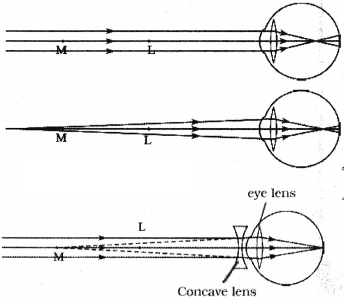
- Some people cannot see objects at long distances but can see nearby objects clearly. This type of defect in vision is called ‘Myopia’ or ‘Near sightedness’.
- Myopia is corrected by using a con-cave lens of focal length equal to the distance of the far point F from the eye.
- This lens diverges the parallel rays from distant object as if they are coming from the far point.
- Finally the eye lens forms a clear im-age at the retina.
Question 2.
Explain the correction of the eye defect Hypermetropia. (AS1)
Answer:
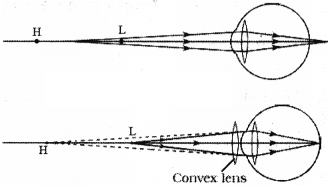
- A person with hypermetropia can see distant objects clearly but cannot see objects at near distances. This is also known as ‘far sightedness’.
- Eye lens can form a clear image on the retina when any object is placed beyond near point.
- To correct the defect of hypermetropia, we need to use a lens which forms an image of an object beyond near point at H, when the object is between H and L. This is possible only when a double con¬vex lens is used.
- The image acts like an object for the eye lens. Hence final image due to eye is formed at retina.
Question 3.
How do you find experimentally the refractive index of material of a prism? (AS1)
(OR)
Write the experimental procedure in finding the refractive index of a prism.
(OR)
Which quantity will decide whether a given medium is denser or rarer? How do you find that quantity of prism experimentally?
Answer:
Refractive index decides whether a medium is denser or rarer.
Aim :
To find the refractive index of a prism.
Materials required :
Glass prism, white chart of size 20 x 20 cm, pencil, pins, scale and protractor.
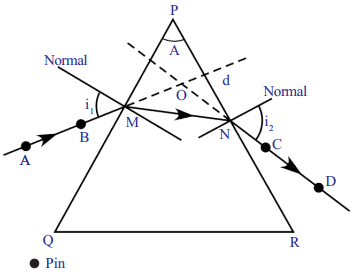
Procedure :
- Keep a prism on white chart.
- Draw the triangular base of the prism with pencil.
- Remove the prism.
- The shape of the outline drawn prism is triangle and name its vertices as P, Q and R.
- PQ and PR be the refracting surfaces.
- Find the angle between PQ and PR. This is the angle of the prism (A) (or) Refracting angle.
- Mark M on PQ and draw a perpendicular line to PQ at M.
- Place the centre of the protractor at M, along the normal and mark an angle of 30° and then draw a line up to M. This line denotes incident ray. This angle is called angle of incidence.
- Place the prism in its position (triangle) again.
- Now fix two pins vertically on the line at points A and B .
- See the images of pins through the 2nd refracting side (PR).
- Fix another two pins at points C and D such that all the four pins appear to lie along the same line.
- Remove the pins and prism, join the pin-holes. Draw the incident and emergent rays.
- The angle between the normal and the emergent ray at N is the angle of emergence.
- The line passing through the points A, B, M, N, C and D represents the path of light when it suffers refraction through prism.
The angle of deviation :
- Extend incident and emergent rays are intercept at a point ‘O’.
- The angle between these two rays is the angle of deviation (d).
- Note the emergent deviation angles for different values of i, in the given table.
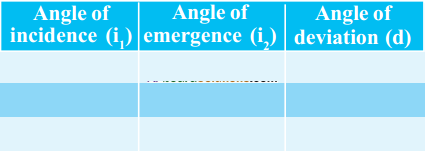
- Draw the graph between angle of incidence on X - axis and the angle of deviation on Y – axis.
- We notice that the angle of deviation decreases first and then increases with increase of the angle of incidence.
- Mark points on a graph paper and join the points to obtain a graph (smooth curve).
- Draw a tangent line to the curve, which parallel to X-axis, at the lowest point of the graph.
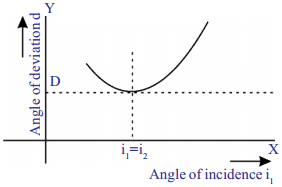
- The point where this line cuts the Y- axis gives the angle of minimum deviation. It is denoted by D.
- From the graph, we notice that, at angle of minimum deviation, the angle of incidence is equal to the angle of emergence.
- By finding A and D we can find refractive index of prism by using formula .
Question 4.
Explain the formation of rainbow. (AS1)
(OR)
What is the natural spectrum occuring in sky? Explain the formation of that spectrum.
Answer:
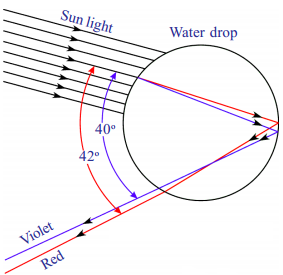
- A rainbow is a natural spectrum of sunlight in the form of bows appearing in the sky when the sun shines on rain drops.
- It is combined result of reflection, refraction and dispersion of sunlight from water droplets, in atmosphere.
- It always forms in the direction opposite to the sun.
- To see a rainbow, the sun be must behind us and the water droplets falls in front of us.
- When a sunlight enters a spherical raindrop, it is refracted and dispersed. The different colours of light are bent in different angles.
- When different colours of light falls on the back inner surface of drop, it (Water drop) reflects (different colours of light) interwnally (total internal reflection).
- The water drops again refract the different colours, when it comes out from the raindrop.
- After leaving this different colours from the raindrop as rainbow, reach our eye. Thus, we see a rainbow.
Question 5.
Explain briefly the reason for the blue of the sky. (AS1)
Answer:
- The reason for blue sky is due to the molecules N2 and O2.
- The size of these molecules are comparable to the wavelength of blue light.
- These molecules act as scattering centres for scattering of blue light.
- So scattering of blue light by molecules of N2 and O2 is responsible for blue of the sky.
Question 6.
Explain two activities for the formation of artificial rainbow. (AS1)
(OR)
Give two activities for the formation of the artificial rainbow? And explain it.
(OR)
Suggest an experiment to create a rainbow in your classroom and explain the procedure.
Answer:
Activity -1 :

- Select a white coated wall on which the sun rays fdll.
- Stand in front of a wall in such a way that the sun rays fall on your back.
- Hold a tube through which water is flowing.
- Place your finger in the tube to obstruct the flow of water.
- Water comes out from small gaps between the tube and finger like a fountain.
- Observe the changes on wall while showering the water.
Activity - II : (Activity - 4)

- Take a metal tray and fill with water.
- Place a mirror in water such that it makes an angle to the water surface.
- Now focus white light on the mirror through the water.
- Keep a white card board sheet above the water surface.
- We may observe the colours VIBGYOR on the board.
- The splitting of white light into different colours (VIBGYOR) is called dispersion.
- So consider a white light is a collection of waves with different wavelengths.
- Violet has shortest wavelength, and red has longest wavelength.
Question 7.
Derive an expression for the refractive index of the material of a prism. (AS1)
Answer:
Derivation of formula for refractive index of a prism :
PQ and PR are refracting surfaces of prism, i, is an angle of incidence, i2 is an angle of emergence, is an angle of refraction of first surface and r2 is an angle of incidence on second surface.
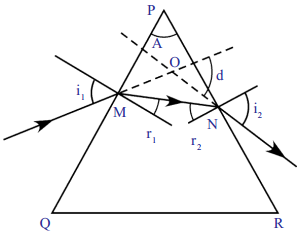
1. From triangle OMN, we get
d = i1- r1+ i2- r2
∴ d = (i1+ i2)-(r1+ r2) ……… (1)
2. From triangle PMN, we have
∠A + (90° - r1) + (90° - r2) = 180°
⇒ r1+ r2= A ……… (2)
3. From (1) and (2),
⇒ d = (i1+ i2) - A
⇒ A + d = i1+ i2
4. This is the relation between angle of incidence, angle of emergence, angle of deviation and angle of prism.
5. From Snell’s law, we know that
n1sin i = n2sin r
6. Let ‘n’ be the refractive index of the prism.
7. Using Snell’s law at M, refractive index of air n1= 1; i = i1; n2= n; r = r1.
⇒ sin i1= n sin r1…………. (4)
8. Similarly, at N, n1= n; i = r2; n2= 1; i1= i2
⇒ n sin r2= n sin i2………… (5)
9. We know that at the angle of minimum deviation position (D), i.e. i1= i2
10. We will notice that MN is parallel to the base of prism QR.
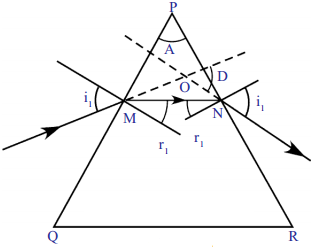
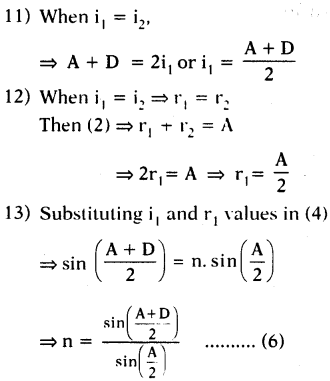
14. This is the formula for the refractive index of the prism.
Question 8.
Light of wavelength λ1enters a medium with refractive index n2 from a medium with refractive index n1 What is the wavelength of light in second medium? (AS1)
Answer:
Wavelength of first medium =λ1
Refractive index of first medium = n1
Let the wavelength of second medium = λ2,
Refractive index of second medium = n2
Light enters from first medium to second medium =⇒n2/n1=c1/c2=λ1/λ2(∵ υ = const)
⇒λ2=λ1n1/n2
Note:
For the below questions the following options are given. Choose the correct option by making hypothesis based on given assertion and reason. Give an explanation.
a) Both A and R are true and R is the correct explanation of A.
b) Both A and R are true and R is not the correct explanation of A.
c) A is true but R is false.
d) Both A and R are false.
e) A is false but R is true.
Question 9.
Assertion (A) : The refractive index of a prism depends only on the kind of glass of which it is made of and the colour of light. (AS2)
Reason (R) : The refractive index of a prism depends on the refracting angle of the prism and the angle of minimum deviation.
Answer:
(b) Both A and R are true and R is not the correct explanation of A.
Question 10.
Assertion (A) : Blue colour of sky appears due to scattering of light.
Reason (R) : Blue colour has shortest wavelength among all colours of white light. (AS2)
Answer:
(C) A is true but R is false.
Question 11.
Suggest an experiment to produce a rainbow in your classroom and explain the procedure. (AS3)
Answer:
Activity to produce a rainbow in classroom :
- Take a prism and place it on the table near a vertical white wall.
- Take a thin wooden plank, make a small hole in it and fix it vertically on the table.
- Place the prism between the wooden plank and wall.
- Place a white light source behind the hole of the wooden plank. Switch on the light.
- Adjust the height of the prism such that the light falls on one of the lateral surfaces.
- Observe the changes in the emerged ray of the prism.
- Adjust the prism by slightly rotating it till you get an image on the wall.
- We observe a band of different colours on the wall.
- These colours are nearly equal to the colours of the rainbow, i.e., VIBGYOR.
Question 12.
Prisms are used in binoculars. Collect information why prisms are used in binoculars. (AS4)
Answer:
- Binoculars consists of a pair of identical or mirror symmetrical telescope mounted side by side and aligned to point accurately in the same direction, allowing the viewer to use both eyes, when viewing distant objects.
- The size of binoculars is reduced by using prisms.
- We get good image with more brightness.
- Objective size and optical quality should be increased by using prisms in binoculars.
Question 13.
Incident ray on one of the face (AB) of prism and emergent ray from the face AC are given in figure. Complete the ray diagram. (AS5)
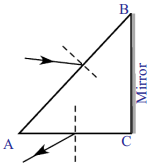
Answer
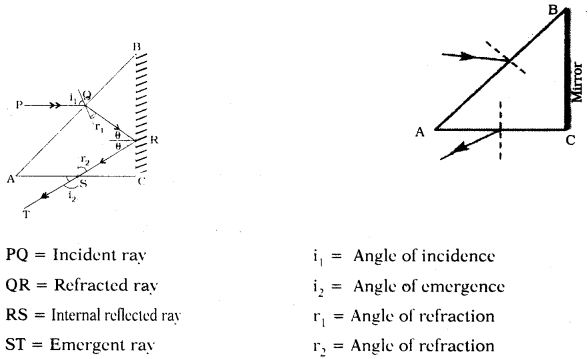
Question 14.
How do you appreciate the role of molecules in the atmosphere for the blue colour of the sky? (AS6)
(OR)
How do you appreciate the nature of molecules, responsible for the blue of the sky?
Answer:
- The sky appear blue due to atmospheric refraction and scattering of light through molecules.
- Molecules are scattering centres.
- The reason to blue sky is due to the molecules N2 and 02.
- The sizes of these molecules are comparable to the wavelength of blue light.
- In the absence of molecules there will be no scattering of sunlight and the sky will appear dark.
- We should appreciate the molecules which are scattering centres.
Question 15.
Eye is the only organ to visualise the colourful world around us. This is possible due to accommodation of eye lens. Prepare a six line stanza expressing your wonderful feelings. (AS6)
Answer:
“Many people simply see
The world in black and white
But through my eyes the world’s alive
So colourful and bright
Don’t close your mind to the sights
That light up the night and day
There’s so much to see here on this earth
And not a rupee do you have to pay”
The most obvious things aren’t the ones
There is beauty in the unknown
with willing eyes and an open mind
The true wonders you will be shown
Question 16.
How do you appreciate the working of ciliary muscles in the eye? (AS6)
(OR)
Which muscles are helpful in changing the focal length of eye lens? How do you appreciate those muscles?
Answer:
- Ciliary muscles are helpful in changing focal length of eye lens.
- The ciliary muscles which attached with eye lens help to change the focal length of eye lens.
- When the eye is focussed on a distant object, these are relaxed. So the focal length of eye lens increases to its maximum value.
- The parallel rays coming into the eye are focussed on the retina then we can see the object clearly.
- When the eye is focussed on a nearer object the muscles are strained so the focal length of eye-lens decreases. The ciliary muscles adjust the focal length and the image is formed on retina then we can see the object.
- Their process of adjusting focal length of eve lens is called accomodation.
- So ciliary muscles must be appreciated for its accomodation of eye lens.
Question 17.
Why does the sky sometimes appear white? (AS7)
(OR)
The sky sometimes appears white. What is the reason behind it?
Answer:
- Our atmosphere contains atoms and molecules of different sizes.
- According to their sizes, they are able to scatter different wavelengths of light.
- For example, the size of the water molecule is greater than the size of the N2 or O2.
- It acts as a scattering centre for light other frequencies which are lower than the frequency of blue light.
- On a hot day due to rise in the temperature, water vapour enters atmosphere which leads to abundant presence of water molecules in atmosphere. These water molecules scatter the colours of other frequencies (other than blue).
- All such colours of other frequencies reach our eye and white colour is appeared to us.
Question 18.
Glass is known to be transparent material. But ground glass is opaque and white in colour. Why? (AS7)
Answer:
- Ground glass is glass whose surface has been ground that produces a flat but rough finish.
- Ground glass has the effect of rendering the glass translucent by scattering of light during transmission thus blurring visibility while still transmitting light.
- To get more permanent frost, the glass may be ground by rubbing with some gritty substance.
Question 19.
If a white sheet of paper is stained with oil, the paper turns transparent. Why? (AS7)
(OR)
What is the reason behind the paper turns transparent when it is immersed in oil?
Answer:
- The paper fibres have higher index of refraction probably much greater than 1.5.
- The oil or fat also has a high index of refraction so that it nearly matches the index of refraction of the paper fibres and it reduces the scattering significantly.
- The fat adhering to the cellulose fibers lowers the index of refraction of the cellulose and also fills in air voids, so that visible light passes through the bag with significantly less scattering.
- The oil connects the fibres in the paper with a liquid which can transmit by refraction (rather than scatter) light that falls upon it. As a result, the paper stained with oil is turned transparent.
Question 20.
A light ray falls on one of the faces of a prism at an angle 40° so that it suffers angle of minimum deviation of 30°. Find the angle of prism and angle of refraction at the given surface. (AS7)
Answer:
Given that, incident ray on one of the prisms (i1) = 40°
Angle of minimum deviation (D) = 30°
Angle of prism (A) = ?
A+D = 2i1
⇒ A = 2i1 - D
⇒ A = 2(40°) -30°
= 80° - 30°
= 50°
∴ Angle of prims (A) = 50°
Angle of refraction (r1) = ?
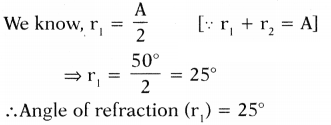
Question 21.
The focal length of a lens suggested to a person with Hypermetropia is 100 cm. Find the distance of near point and power of the lens. (AS7)
Answer:
i) The distance of near point :
If the distance of near point is ‘d’ and focal length is ‘f’ then the relation between
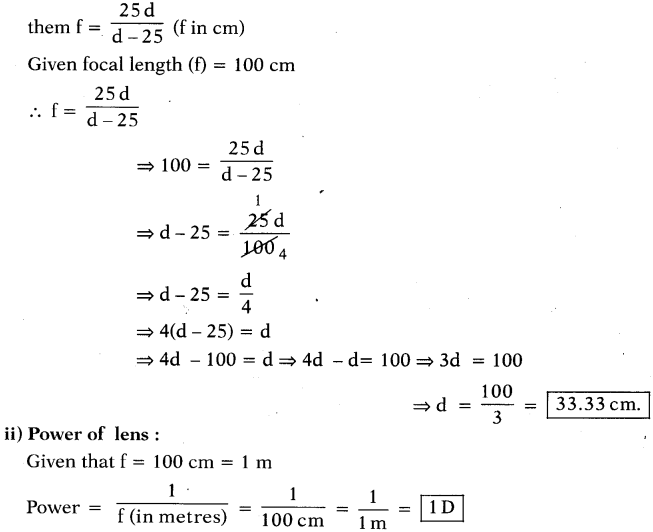
Question 22.
A person is viewing an extended object. If a converging lens is placed in front of his eye, will he feel that the size of object has increased? Why? (AS7)
Answer:
- A simple magnifier allows us to put the object closer to the eye than we could normally focus and forms an enlarged virtual images.
- The principle behind this is angular magnification.
- The magnification is Ma = 25/f for the close focus point, but since that causes eye strain, it is usually desirable to put the images at infinity giving Ma = 25/f
- So he fees the size of object is increased. The reason is mentioned.
- Angular magnification: ‘The ratio of the angle substended at the eye by the image formed by an optical instrument to the angle substended at the eye by the object being viewed.”